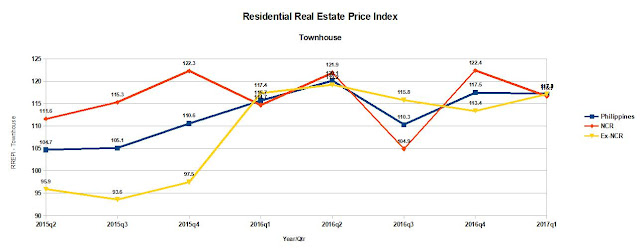Perhaps because the index has been in its infancy but according to
BSP's Residential Real Estate Price Index (RREPI) investors in residential real estate have been experiencing a nausea-inducing roller-coaster ride in terms of asset prices.
The swings in the areas outside the National Capital Region (Ex-NCR) are particularly problematic. Within the past two years, RREPI - All Types for the Ex-NCR area has swung from a high of 125.7 in the second quarter of 2016 from a low of 106.2 as of the 2nd Qtr. of 2015, an increase of 15.51% in just one year. Then in the next quarter, the index drops by 10.74% to 112.2 as of the 3rd Qtr of 2016. The RREPI - All Types index for the Ex-NCR area now rests at 116.8 as of the 1st Qtr 2017 or 4.10% higher than what it was just two quarters ago.
This volatility of the Ex-NCR RREPI-All Types has influenced large swings in the overall Philippine RREPI-All Types. Since its inception, the nationwide index has swung 10.18% from bottom to top. No doubt, the volatility of the Philippine-wide RREPI-All Types was tempered by the low volatility of the NCR RREPI - All Types, which fluctuated by only 2.63% from peak to trough.
The same dynamic has been playing out as you drill down into the index's sub-sectors, whether they be Single Detached Homes, Duplex, Townhouses, or Condominiums. Ex-NCR is volatile while NCR has smoother fluctuations, leading to a more volatile nationwide index for each sub-sector.
The Philippines was one of the last countries in the ASEAN to institute a National Residential Real Estate Index. Other countries have done this much sooner. However, late is better than never. In the meantime, for planning purposes, the index has limited utility.















